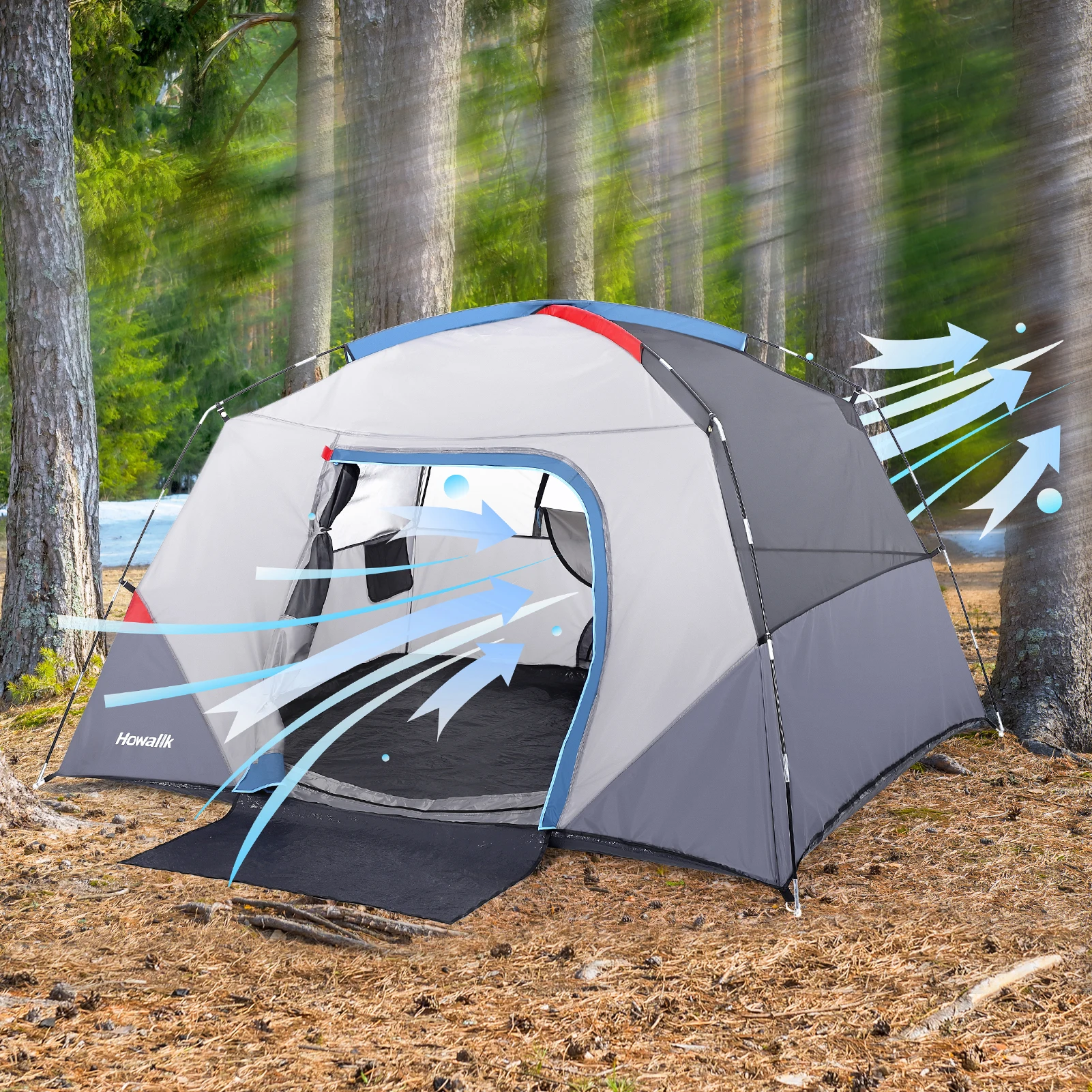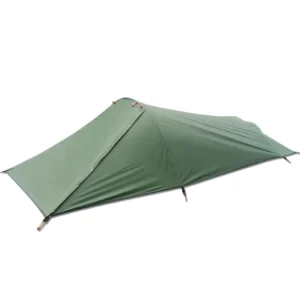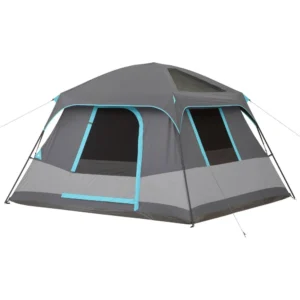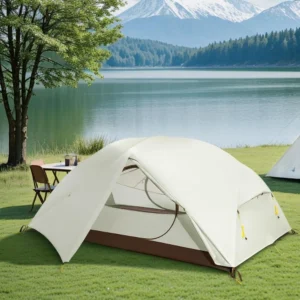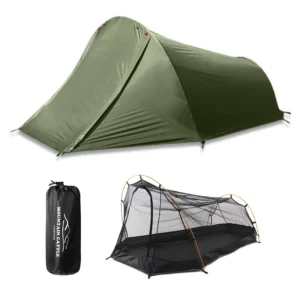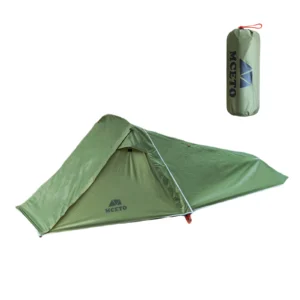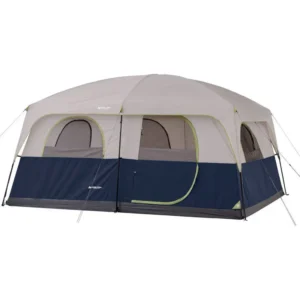Understanding Dome Tent Capacity Ratings
Dome tents are among the most popular camping shelters, characterized by their semi-spherical shape formed by flexible poles that cross at the top. Their design offers excellent stability and weather resistance while providing reasonably good interior space. But when it comes to how many people can actually fit inside comfortably, manufacturer ratings can be misleading.
When you see a “4-person tent” label, you might envision four adults sleeping comfortably with room for gear. The reality, however, is quite different. Manufacturer person ratings are typically based on a simple calculation: how many standard sleeping bags can fit side-by-side on the floor – nothing more.
Here’s what those manufacturer ratings typically assume:
– Each person requires only 20-24 inches (50-61 cm) of width (a standard sleeping pad)
– Occupants are packed in like sardines with no space between sleeping areas
– Little to no gear storage space is included in the calculation
– The sloping walls of the dome don’t affect usable space
This disconnect between technical capacity and comfortable capacity creates what experienced campers call the “squeeze factor” – the uncomfortable reality of trying to fit the rated number of people in most tents.
Common dome tent sizes include:
– 1-2 person (ultralight to standard)
– 3-4 person (small family or couple with gear)
– 5-6 person (medium family)
– 8+ person (large family or group)
– Large geodesic domes (expedition or base camp models)
Understanding the structure and design principles of dome tents for two people gives you better insight into how capacity ratings work in practice. The basic dome tent structure affects usable space significantly more than many first-time buyers realize.
Critical Factors That Determine Comfortable Capacity
Several crucial elements determine how many people can comfortably occupy a dome tent, extending well beyond the simple manufacturer rating:
Floor Area and Dimensions
The total square footage is the most critical factor. For genuine comfort, most adults need 20-25 square feet (1.9-2.3 square meters) of floor space. This gives enough room for a sleeping pad plus some personal items.
Peak Height and Wall Slope
Unlike cabin-style tents with vertical walls, dome tents have significantly sloped sides. This means the stated floor dimensions don’t translate to usable space throughout the tent. A 7×7 foot floor doesn’t equal 49 square feet of usable space because the sloping walls reduce headroom around the perimeter.
Gear Storage Requirements
Camping requires gear – sleeping bags, backpacks, clothing, and more. Without adequate storage options, these items consume valuable floor space, effectively reducing the number of people the tent can accommodate.
Vestibule Importance
A tent vestibule is a covered exterior storage area that can substantially increase usable space by moving gear outside the sleeping area while keeping it protected from the elements. Tents without vestibules require more interior space for gear storage.
Occupant Considerations
Adults require more space than children. Similarly, larger individuals need more room than smaller ones. A “4-person” tent might work for two adults and two small children but would be extremely tight for four full-sized adults.
Trip Type Influence
Backpackers typically accept tighter quarters to minimize weight. Car campers, with no need to carry their tent long distances, usually prioritize comfort and space over packability.
Personal Comfort Preferences
Some campers don’t mind close quarters, while others feel claustrophobic without ample personal space. Your comfort threshold is highly individual and should factor into your tent selection.
Practical Rules of Thumb for Tent Selection
To find the right sized dome tent for your needs, experienced campers rely on these tried-and-true guidelines:
1. The “Subtract Two” Rule
For comfortable family car camping, subtract two from the manufacturer’s person rating. A 4-person tent is ideal for two people, a 6-person tent works well for four people, and so on. This allows adequate space for gear and movement.
2. The “Subtract One” Rule
For backpackers who prioritize lighter weight but still want reasonable comfort, subtract one from the manufacturer’s rating. A 3-person backpacking tent works well for two people with moderate gear.
3. The “Gear as a Person” Calculation
Consider bulky gear as taking up the space of an extra person. A couple with a large dog and significant gear might want a 4-person tent despite being just two humans.
4. Square Footage Guidelines
Calculate approximately 20-25 square feet (1.9-2.3 square meters) per adult for comfortable camping. If a tent has 80 square feet of floor space, it will comfortably sleep 3-4 adults, regardless of its “person” rating.
The stability and usable space of your tent are also impacted by the specific dome tent shape and design, with extended dome designs offering more usable interior space than perfect hemispheres.
Dome Tent Selection: A Step-by-Step Approach
Finding your ideal dome tent involves more than just looking at person ratings. Follow these steps for the best match to your needs:
1. Calculate Your True Headcount
Start by counting all occupants, including adults, children, and pets. Remember that active dogs may need as much space as a small person.
2. Assess Gear Storage Needs
Inventory your typical camping gear. Weekend campers bring less than those on extended trips. Consider whether items can be stored in your vehicle or need protection in the tent or vestibule.
3. Evaluate Your Comfort Preferences
Be honest about personal space requirements. Some people sleep comfortably in close proximity; others need room to stretch out. Factor this into your calculations.
4. Consider Your Trip Type
Backpackers need to balance comfort with weight and packability. Car campers can prioritize space without weight concerns. Your typical camping style should influence your size selection.
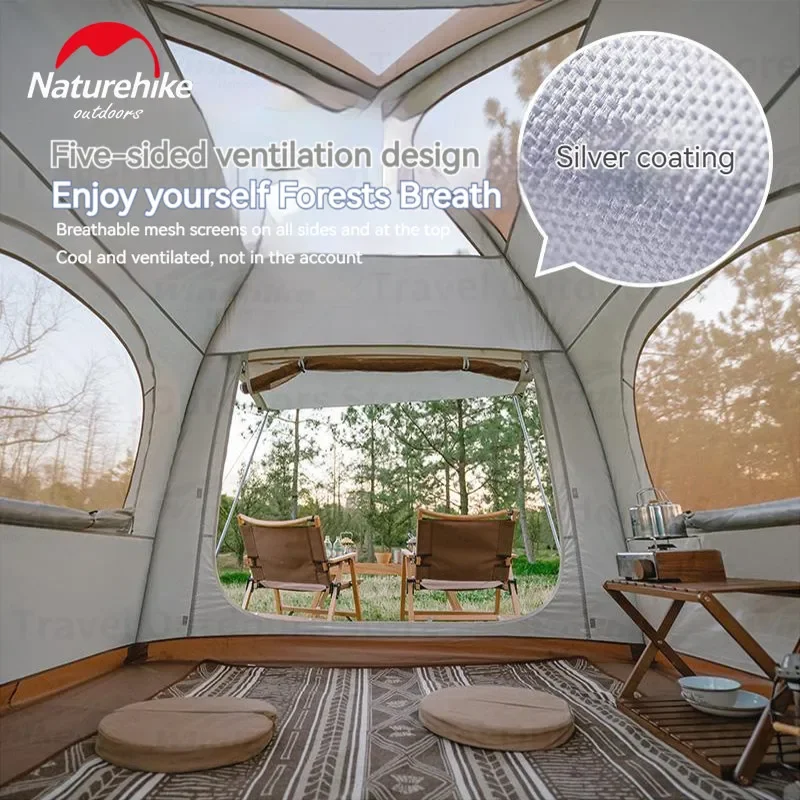
5. Examine Specific Tent Dimensions
Look beyond the person rating to actual measurements. A 7’ × 8’ floor (56 square feet or 5.2 square meters) tells you more about usable space than “4-person” on the label. Also check the length – 80 inches (203 cm) is typically the minimum for adult comfort.
6. Research User Feedback
Read reviews from actual users, particularly those with similar group compositions to yours. They often provide realistic capacity assessments based on real-world use.
7. Test Setup When Possible
Whenever available, set up the tent in-store or borrow one from a friend to evaluate the actual space. This hands-on approach provides the most accurate feel for the tent’s true capacity.
The importance of adequate standing height in tents shouldn’t be overlooked, as it drastically affects comfort during longer camping trips when you’ll be spending time in the tent beyond sleeping.
Key Features That Affect Usable Space
Several design features can significantly impact how spacious a tent feels, regardless of its official dimensions:
Multiple Doors
Multiple access points reduce the need to crawl over tentmates to enter or exit. This seemingly small feature dramatically improves the livability of shared tent space, particularly for midnight bathroom trips.
Internal Organization Systems
Built-in storage options like mesh pockets, gear lofts, and hanging hooks can free up 3-5 square feet (0.3-0.5 square meters) of valuable floor space by getting items off the ground and onto walls or overhead areas.
Ventilation Features
Good airflow makes spaces feel larger and more comfortable. Well-placed windows and vents prevent condensation and stuffiness that can make adequate spaces feel cramped and unpleasant.
Tent Shape Variations
Extended dome designs with rectangular rather than square floors often provide more usable space than traditional hemispheres. Instant dome tents and hybrid designs may offer different space efficiencies compared to classic dome structures.
Vestibule Configuration
Single versus double vestibules affects where and how you can store gear. Double vestibules allow access from both sides and provide more protected external storage, effectively increasing usable interior space.
Room Dividers
Some larger dome tents include removable dividers that create separate rooms. While they don’t increase total space, they do provide privacy that can make shared accommodations more comfortable, particularly for family camping.
Real-World Capacity Examples: Popular Dome Tent Sizes
Here’s how various dome tent sizes typically work in real-world camping scenarios:
2-Person Dome Reality
Rated For: 2 people
Actually Fits: 1 person with gear, or 2 slender adults with minimal gear
Typical Dimensions: 7’ × 5’ (35 sq ft/3.3 sq m) floor, 40-48” (102-122 cm) peak height
Best For: Solo backpackers with gear, ultralight couples
3-Person Dome Reality
Rated For: 3 people
Actually Fits: 2 adults with moderate gear
Typical Dimensions: 7’ × 6.5’ (45.5 sq ft/4.2 sq m) floor, 44-52” (112-132 cm) peak height
Best For: Couples who want comfort, two backpacking friends
4-Person Dome Reality
Rated For: 4 people
Actually Fits: 2 adults + 1-2 small children, or 3 adults with minimal gear
Typical Dimensions: 8’ × 7’ (56 sq ft/5.2 sq m) floor, 52-60” (132-152 cm) peak height
Best For: Small families, couples with pets or who want extra space
Our selection of quality dome camping tents offers various configurations to match these real-world needs.
6-Person Dome Reality
Rated For: 6 people
Actually Fits: 4 adults comfortably, or a family of 4-5 with moderate gear
Typical Dimensions: 10’ × 9’ (90 sq ft/8.4 sq m) floor, 68-72” (173-183 cm) peak height
Best For: Medium families, double-date camping trips
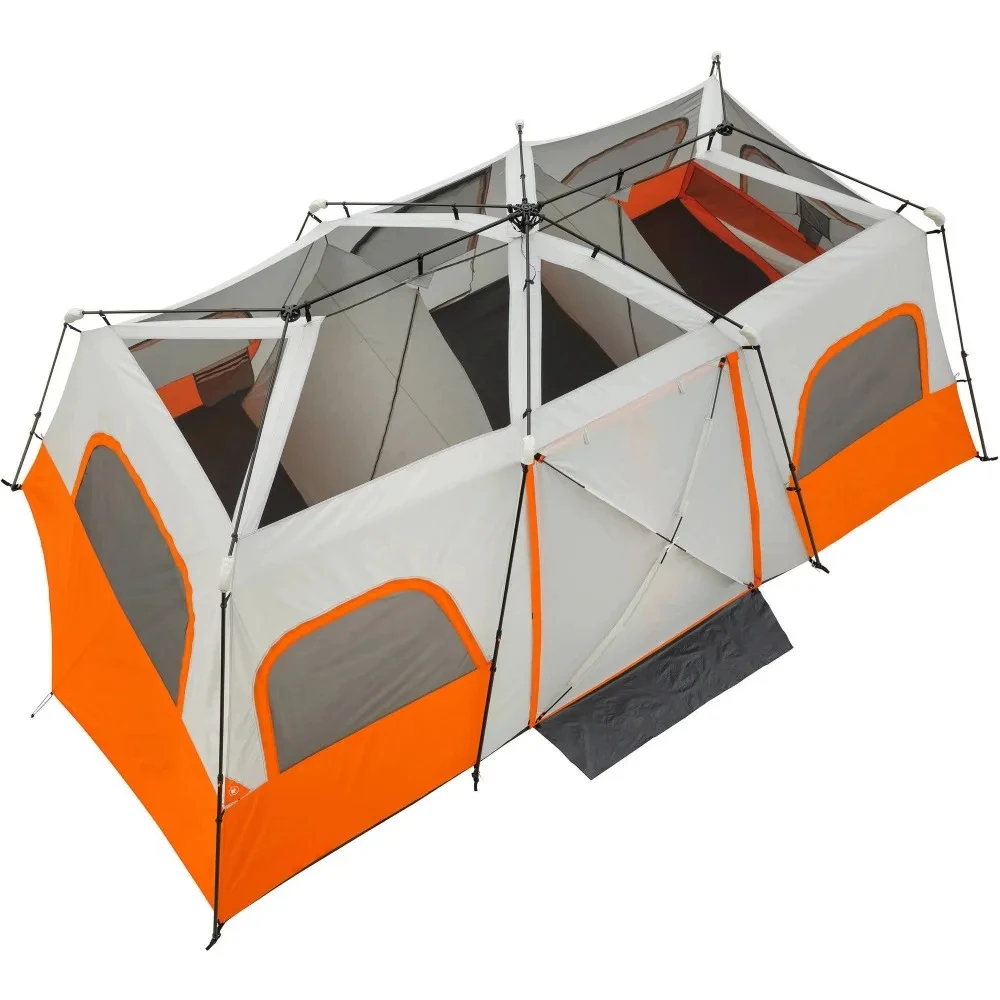
8-Person Dome Reality
Rated For: 8 people
Actually Fits: 5-6 adults, or a family of 6
Typical Dimensions: 12’ × 10’ (120 sq ft/11.1 sq m) floor, 72-76” (183-193 cm) peak height
Best For: Large families, small groups of friends
Lightweight Backpacking Tent, Ultralight Backpacking Tent, Ultralight Bivy Tent
Ultralight Single Person Camping Tent with Aluminum Poles for 3-Season Backpacking Waterproof DesignPrice range: $94.88 through $326.82 Select options This product has multiple variants. The options may be chosen on the product pageTall / Stand Up Camping Tent, Two Room Camping Tent
$407.93 Select options This product has multiple variants. The options may be chosen on the product pageLightweight Backpacking Tent, Ultralight Backpacking Tent, Waterproof Backpacking Tent
$391.05 Select options This product has multiple variants. The options may be chosen on the product pageCompact Backpacking Tent, Lightweight Backpacking Tent, Waterproof Camping Tent
$335.52 Select options This product has multiple variants. The options may be chosen on the product pageBackpacking Tent with Vestibule, Freestanding Backpacking Tent, Lightweight Backpacking Tent
Price range: $446.89 through $447.22 Select options This product has multiple variants. The options may be chosen on the product page- $476.52 Select options This product has multiple variants. The options may be chosen on the product page
Family Camping: Special Considerations for Dome Tent Sizing
Family camping introduces unique considerations when selecting a dome tent:
Planning for Growth
Children grow quickly – the tent that fits your family perfectly today may be cramped next season. Consider buying with future needs in mind, especially if camping will be a regular activity.
Privacy Benefits
For families with older children or teens, two-room camping tents with room dividers provide valuable privacy. These separate spaces make extended camping trips more harmonious for everyone.
Weather Contingency Space
Families need extra interior space for rainy days when everyone is confined inside. Activities like card games, reading, or simply moving around require more room than just sleeping arrangements.
Organized Family Gear
Multiple family members mean multiplied gear. Dedicated storage areas for each person’s belongings help maintain organization and reduce conflicts over space.
Backpacking with Dome Tents: When Weight Matters
Backpackers face different tent sizing considerations due to weight constraints:
Weight-Space Tradeoff
Every square foot of tent space adds weight to your pack. Backpacking dome tents typically weigh 3-5 pounds (1.4-2.3 kg) for a 2-person model, with larger sizes adding significant weight.
Ultralight Considerations
Ultralight dome tents offer impressive weight savings but with notably tighter quarters. These minimalist shelters often have lower peak heights, steeper wall slopes, and fewer comfort features.
Space Maximization Techniques
Backpackers develop techniques to maximize limited tent space: storing gear in vestibules, using compression sacks, and developing efficient packing systems inside the tent.
The advantages of two-person dome tents for backpacking include better weight distribution between hikers and adequate space for two without excessive pack weight.
FAQ: Your Dome Tent Capacity Questions Answered
Is a 4-person dome tent actually good for 4 people?
No, a 4-person dome tent comfortably fits 2-3 adults. Four adults would be extremely cramped with no room for gear. For four people to sleep comfortably with basic gear, look for a 6-person or larger tent.
Can I fit a queen air mattress in a 3-person dome tent?
Maybe, but it’s tight. A standard queen air mattress measures 60” × 80” (152 × 203 cm), which would leave very little room for anything else in a typical 3-person dome. A 4-person tent is better suited for a queen mattress plus minimal gear.
Should I always buy a bigger tent than I need?
For car camping, yes – buying larger generally improves comfort with minimal downsides. For backpacking, balanced sizing is crucial as every extra square foot adds weight to your pack. Consider lightweight backpacking tent options if weight is a concern.
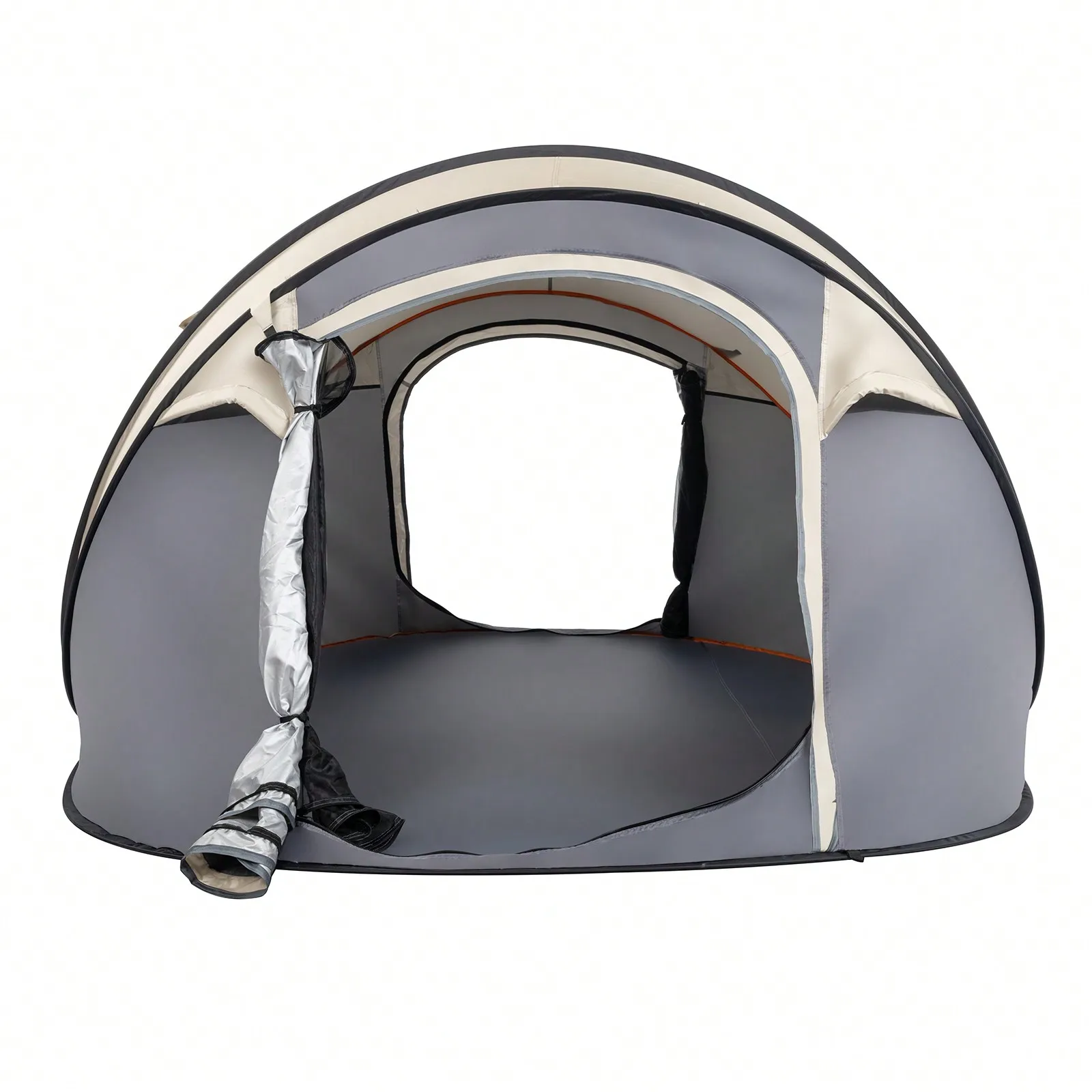
How do dome tents compare to cabin tents for space efficiency?
Cabin tents offer more usable interior space due to their vertical walls but are typically heavier and less stable in wind. Dome tents have better stability but their sloped walls reduce usable interior volume, especially around the edges.
Are dome tents comfortable for tall people?
It depends on the specific tent. Look for dome tents that are at least 80” (203 cm) in length, and check the peak height. Tall campers should prioritize extended dome designs rather than perfect hemispheres for more headroom.
Conclusion: Finding Your Perfect Dome Tent Size
The gap between manufacturer capacity ratings and comfortable reality is clear: most dome tents hold fewer people comfortably than their rating suggests. Understanding this discrepancy is the first step toward selecting a tent that truly meets your needs.
When choosing your ideal dome tent, remember this practical formula: For comfortable camping, your ideal tent capacity = number of people + 1 (or + 2 for extended trips with substantial gear). This simple calculation will steer you toward a more realistic size.
Every camping group has unique needs based on occupant size, gear requirements, and comfort preferences. By considering floor dimensions, peak height, feature set, and real-world capacity rather than just the manufacturer’s person rating, you’ll find a dome tent that provides the space you actually need for enjoyable outdoor adventures.

